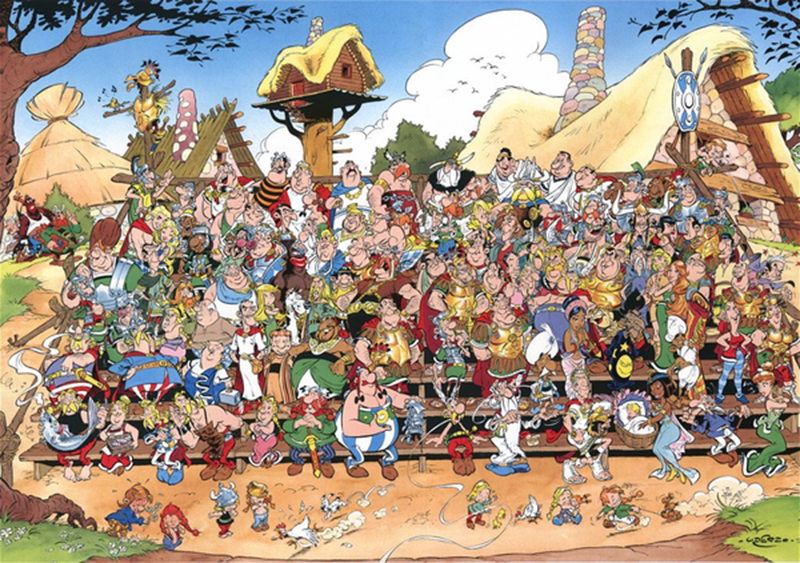“Like Marcus Sacapus, right Papa?” my eight-year-old Lolo said to Philippe one morning as we were eating breakfast at the kitchen counter.
“Exactement, comme Marcus Sacapus!” Philippe said, grinning. Even if Lolo still preferred to speak English back to him, this new project of his was bearing fruit. Lolo was becoming more and more French each day.
Of course I didn’t know what was exactement like anything in this conversation. The culture of French childhood had totally escaped me. “Who’s Marcus Sacapus?” I asked.
“Mommy!” Lolo called back, her voice undulating in a way that says you-are-so-stupid. “Marcus Sacapus is Marcus-Sac-A-Pus! Get it?”
I so didn’t get it.
“Like sac à puces!,” she insisted.
Sac à puces. Fleabag. Or more precisely, a flea-infested animal. I got it, sort of, but I still didn’t know who Marcus was.
Instead of Marcus, actually, I thought of Gianluca. He was an enthusiastic Italian colleague from years ago, the one to whom we always had to say, “That’s great, Gianluca. Now explain it again, this time from the beginning.”
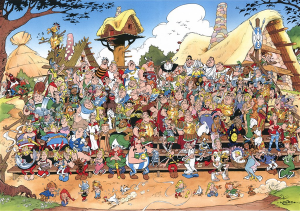
At least I knew the context of that breakfast conversation. Philippe was teaching Lolo about Astérix and his sidekick Obélix.
The series of comics was one of Philippe’s favourites when he grew up in Quebec. Since its initial publication in 1959, Astérix has been equally adored in France and, after translation, in many other European countries. The famed actor Gérard Depardieu even played Obélix in four Astérix et Obélix films.
The stories chronicle the adventures of these two characters, Astérix and Obélix, who are occupants of a village in Gaul (present-day France, Belgium, Luxembourg and other bits of Western Europe). The year is 50 B.C., and these Gauls have enjoyed marvelous success in resisting Roman occupation. Their winning strategy? Drinking a magic potion brewed by their local druid Panoramix.
It’s hardly fairies and animal rescues, the type of fodder that attracts my daughter these days, but by force of enthusiasm, Philippe seems to have pushed Astérix and his mob to the fore.
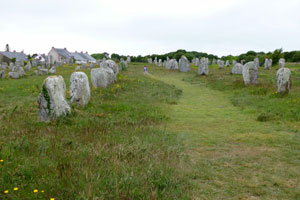
That this whole, educational mission began during our family’s trip to Brittany last month is hardly a coincidence. Astérix’s Gaulish village lies in Brittany. And Lolo’s first encounter with the cartoon characters occurred there in the city of Carnac, at the gift shop situated next to the area’s menhirs, a striking collection of small Stonehenges. The day job of Astérix’s enormous chum Obélix, in fact, is to make deliveries of these enormous rocks. Obélix: obélisques in French, obelisks in English. It’s that sort of humour that is embedded in the names.
When we visited that gift shop in Carnac, Philippe went straight for the children’s bookshelves, which were situated right next to the cashier. There was only one volume of Astérix available – number 23 to be exact – unsurprisingly the one entitled Obélix et Compagnie. Here, standing near the cash register as people made their purchases, Philippe spent a good 20 minutes reading this book aloud, and with great animation – to Lolo, the cashier and all other shoppers.

That day our daughter looked at the colourful pages and cartoon characters wearing Roman tunics and helmets with a mixture of interest and implausibility. The names of the Gauls – the good guys – all ended in “-ix”, Philippe explained, because that was the way several of the real chieftains’ names ended back those days. He introduced the protagonists Astérix and Obélix. There was also Obélix’s dog, Idéfix.
He slowed to translate for our eight-year old. Idéfix. The dog’s name was like idée fixe. You know, like fixed idea. Get it?
Maybe so, but what was certain in Lolo’s mind was Philippe’s enthusiasm. A couple shoppers smiled knowingly as they approached the cash register. Lolo nodded, willing herself to understand idée fixe.
Then, Philippe explained, there was Panoramix (the village druid, the man who by his name seemed to encompass everything). More courageously, there was Abraracourcix (the village chief whose name stemmed from the adjective abracadabrant, or preposterous) and Assurancetourix (the village bard whose name resembled assurance touriste, or tourist insurance).
The jokes were as much for adults as for kids, I realized. Each of these characters represented a sort of job or, more generally, a certain type of person in life. Caricatures and stereotypes formed the very basis of the series!
Philippe found a map at the beginning of the book. Astérix’s village was situated at Brittany’s seaside, encircled menacingly by Roman camps. And see here? he said with evident glee. All the Roman camp names end in “-um”, just like many place names in Latin! There’s the camp called Aquarium. There’s another camp called Babaorum – like the dessert, get it? And there’s Petibonum. Petit bonhomme. Little fellow. Get it?
Lolo laughed, half for understanding the map, I think, and half for enjoying the boyish enthusiasm of her papa.
Now, anchored again in Antibes, Astérix and his buddies crop up in our household conversation with some regularity. My husband and daughter have spent untold hours reading the series together this summer. Local friends who hear of the educational undertaking chez les canadiens nod in appreciation. “Every French person has read it,” Philippe insists to me. “It’s part of the culture.”
One character that comes into our conversation more frequently than the others is Amérix. The context is far-fetched, but remember cartoons come alive. Who, growing up, ever doubted that Snoopy should walk on his hind legs? Or that Calvin’s stuffed tiger Hobbs really talks when no one else is around?
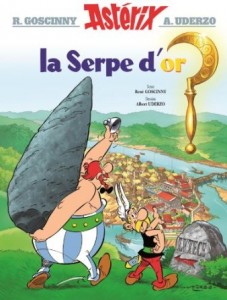
Philippe and Lolo recently explained this guy Amérix to me. Apparently Panoramix, the revered druid of the Gaul village, was distraught because he broke his serpe d’or, his golden sickle, and without his serpe d’or he could not attend the annual assembly of druids.
Astérix suggested buying another one.
Panoramix remained anxious. Good serpes d’or were very rare, he said. The best ones – the only ones he’d accept – were made in a faraway place by the famous Amérix.
“Get it?” Philippe said to me. “Only the best ones are made in America. In the US!”
Yes, I got it. The story continued that Astérix would accompany Panoramix to this far-off land. Obélix would go, too, as Amérix was his distant cousin. Amérix, Obélix explained, was the one in his family who was a success story.
Philippe thought it was hilarious. Lolo giggled because he was laughing, I think. And I chuckled at the quip on the US’s supremacy. What was written in the 60s, at the height of the Cold War, has remained a relevant joke.
But now, at last, I’m getting more thoroughly educated in things Astérix. We’ve just finished dinner on Bellevue’s terrace, and Lolo already has scampered off. As the cicadas continue their evening symphony and the late sun edges toward the horizon on the opposite side of the bay, Philippe becomes the teacher. He goes upstairs to our daughter’s room and grabs their growing collection of Astérix books. He returns to the table and begins flipping through their vivid pages, stopping to explain various names.
My eight-year old, I gather, has already met several Roman centurions, all with the appropriate “-us” suffixes. There’s Caligula Minus. Caligula was one of the most feared Roman emperors, Philippe says, reminding me of history I probably never knew. And minus means runt or loser. There are other Romans called Biscornus (having two horns) and Absolutementexclus (totally excluded). There’s Caius Saugrenus (saugrenu means ludicrous). And this is where Marcus Sacapus, the man who’s a fleabag, fits in. Of course he’s a Roman.
Philippe explains Astérix and his friends and the villages and the series’ entire modus operandi of defeating the Romans. He does this without a single mention of the magic potion that gives the Gauls their extraordinary strength in the first place. I guess I am just supposed to know about that. Fortunately, as I am not French, there are things like Wikipedia.
Truth be told, though, I think I’m finally beginning to get this whole Astérix thing. The stuff does get funnier the more you hear it, sort of like John Cleese’s antics in Fawlty Towers.
But at the same time I do worry about this comic series. I appreciate that my daughter can glimpse the world through another set of binoculars, but what about the case of Amérix, when those binoculars are trained back on the very culture from which she hails? What is she learning about the land of her own passport? And for that matter, what attitudes are being reinforced on generations of French (and Quebecois) schoolchildren?
Or, put an entirely different way, perhaps the binoculars are actually turned inward on Astérix’s Gaulish community. Here is a small, isolationist village, inhabited by a gang that’s different from most and who always dig in their heels to get their way. Sound familiar?
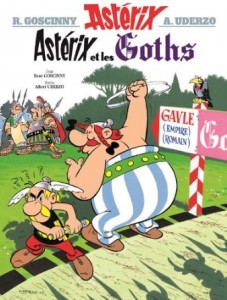
The cicadas have halted their evening chorus momentarily when Philippe moves onto the third book in the series, the one he’s reading with Lolo at the moment. This volume has a go at the Germans – which, I should mention, is my ancestry from generations back and therefore Lolo’s half-ancestry from one further generation back. The speech bubbles of the German characters are written in a Gothic font.
The Germans’ chief is Téléferic. Téléphérique. A cable car. Their treasonous interpreter is Cloridric. Chlorhydrique. Hydrochloric in English, an adjective I only associate with the highly corrosive acid. Another German is called Général Electric. His buddy is Passmoilcric.
Philippe leans back in his chair on Bellevue’s terrace, laughing like a schoolboy as he explains this one to me. Passmoilcric. Passe-moi-le-cric! A cric is a car jack, he says, pumping his arms. Pass me the car jack! It’s evidently hilarious.
We whizz through more names and places. Finally he stops on Agecanonichou, who’s then called Agecanonichet. Philippe’s laughing hard now. “It’s so funny,” he says. “I mean it’s just so funny.”
They are pet names – names of endearment even – bestowed on Agecanonix by his glamourous sweetheart. Agecanonix. Âge canonique. A venerable age. “The guy is about 90 years old!” Philippe explains.
I don’t get it. I mean, I get it, but is it really that funny?
Philippe’s still laughing. Finally he says, “You have to be French.” And with this explanation, he somehow manages a perfect Gallic shrug.

